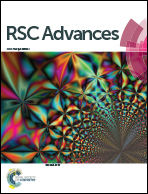Graphene quantum dots modified ZnO + Cu heterostructure photocatalysts with enhanced photocatalytic performance†
Abstract
ZnO represents a typical class of semiconductor oxide with unique photocatalytic activity. However, its photocatalytic activity under continuous ultraviolet (UV) light irradiation is greatly limited by fast carrier recombination and photocorrosion behavior. Two of the most effective methods to solve the challenges are blending with electron acceptor materials and surface modification. Here, a novel heterostructure photocatalyst of a graphene quantum dot (GQD) surface modified ZnO + Cu composite was prepared via a simple spin-coating and annealing process. This photocatalyst exhibits significant improvements in UV-light irradiated photodegradation of rhodamine B (RhB) compared to ZnO. The improved photocatalytic ability could be attributed to the synergistic effects of Cu nanoparticles (NPs) and GQDs, which play an important role in light absorption, charge separation and transfer, and photocorrosion. Meanwhile, the enhanced degree is related to the amount of surface modified GQDs.


 Please wait while we load your content...
Please wait while we load your content...